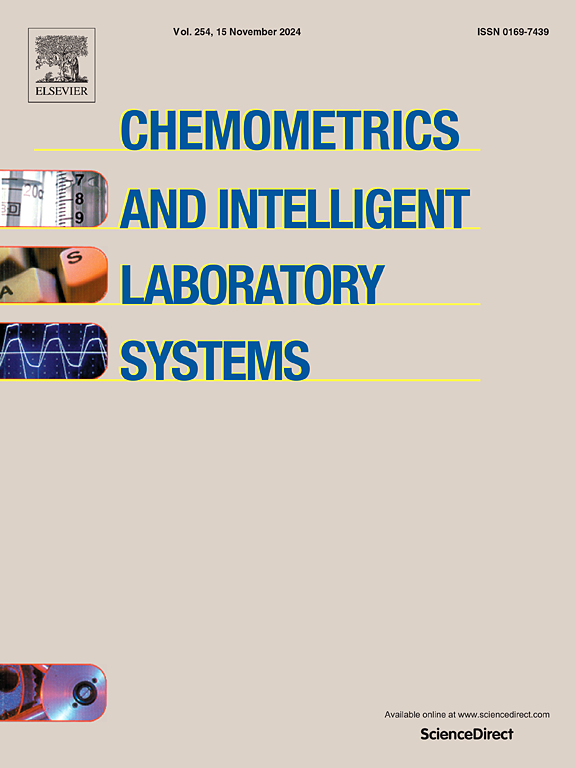不同产地云南多叶巴黎的红外光谱差异分析及快速鉴定
IF 3.8
2区 化学
Q2 AUTOMATION & CONTROL SYSTEMS
Chemometrics and Intelligent Laboratory Systems
Pub Date : 2025-07-28
DOI:10.1016/j.chemolab.2025.105496
引用次数: 0
摘要
云南多叶巴黎(Paris polyphylla var. yunnanensis, PPY)是一种重要的药用植物资源,但其品质受生长环境影响较大。市场上有许多混合用途,但很难区分好与坏。因此,快速追溯PPY的地理来源对药品的安全性和有效性具有重要意义。本研究通过对传统傅里叶变换红外光谱(FI-IRS)、二阶导数红外光谱(SD-IRS)和二维相关光谱(2DCOS)图像的分析,研究了不同来源的PPY的光谱差异。采用层次分析法(HCA)和主成分分析法(PCA)对不同地点的聚类形成进行初步探索,然后采用偏最小二乘判别分析(PLS-DA)、支持向量机(SVM)、极限学习机(ELM)、决策树(DT)、反向传播神经网络(BPNN)、残差卷积神经网络(ResNet) 6种机器学习算法对聚类起源进行追溯。旨在为各地的PPY研究提供丰富的方法参考。结果表明,FT-IRS能较好地表征不同地区的PPY差异,PLS-DA、SVM和ResNet均取得了较好的效果,其中ResNet模型的准确率达到100%。其他模型的性能可能与数据集的大小有关。本研究结果可促进PPY的快速质量检测,为PPY的用药安全性提供保障。本文章由计算机程序翻译,如有差异,请以英文原文为准。
Infrared spectrum difference analysis and rapid identification of Paris polyphylla var. yunnanensis from different geographical origin
Paris polyphylla var. yunnanensis (PPY) is an important medicinal plant resource, but its quality is greatly affected by the growing environment. There are many mixed uses in the market, but it's difficult to distinguish the good from the bad. Therefore, rapid geographical origin traceability of PPY is of great significance for the safety and efficacy of medication. In this study, through the analysis of conventional Fourier transform infrared spectroscopy (FI-IRS), second-derivative infrared spectroscopy (SD-IRS) and two-dimensional correlation spectroscopy (2DCOS) images, the spectral differences of PPY from different origin were investigated. Hierarchical (HCA) and principal component analysis (PCA) were used to conduct a preliminary exploration of the clustering formation of PPY samples from different places, and then, partial least squares discriminant analysis (PLS-DA), support vector machine (SVM), extreme learning machine (ELM), decision tree (DT), back propagation neural network (BPNN), residual convolutional neural network (ResNet) 6 machine learning algorithms were used to trace the origin of PPY, aiming to provide a rich method reference for the research of PPY from different places. The results showed that FT-IRS could characterize the difference of PPY in different places, PLS-DA, SVM and ResNet all obtained good results, and ResNet model could reach 100 % accuracy. The performance of other models may be related to the size of the data set. The results of this study can promote the rapid quality detection of PPY and provide guarantee for the drug safety of PPY.
求助全文
通过发布文献求助,成功后即可免费获取论文全文。
去求助
来源期刊
CiteScore
7.50
自引率
7.70%
发文量
169
审稿时长
3.4 months
期刊介绍:
Chemometrics and Intelligent Laboratory Systems publishes original research papers, short communications, reviews, tutorials and Original Software Publications reporting on development of novel statistical, mathematical, or computer techniques in Chemistry and related disciplines.
Chemometrics is the chemical discipline that uses mathematical and statistical methods to design or select optimal procedures and experiments, and to provide maximum chemical information by analysing chemical data.
The journal deals with the following topics:
1) Development of new statistical, mathematical and chemometrical methods for Chemistry and related fields (Environmental Chemistry, Biochemistry, Toxicology, System Biology, -Omics, etc.)
2) Novel applications of chemometrics to all branches of Chemistry and related fields (typical domains of interest are: process data analysis, experimental design, data mining, signal processing, supervised modelling, decision making, robust statistics, mixture analysis, multivariate calibration etc.) Routine applications of established chemometrical techniques will not be considered.
3) Development of new software that provides novel tools or truly advances the use of chemometrical methods.
4) Well characterized data sets to test performance for the new methods and software.
The journal complies with International Committee of Medical Journal Editors'' Uniform requirements for manuscripts.

 求助内容:
求助内容: 应助结果提醒方式:
应助结果提醒方式:


